
39
Tạp chí Y Dược học - Trường Đại học Y Dược Huế - Số 1, tập 12, tháng 2/2022
Nghiên cứu in vitro tác dụng của gel glycerine và băng mylar lên khả
năng khít sát bề mặt của inlay gắn bằng composite
Lê Hà Thùy Nhung1, Trần Tấn Tài1*
(1) Khoa Răng Hàm Mặt, Trường Đại học Y - Dược, Đại học Huế
Tóm tắt
Đặt vấn đề: Inlay sứ không kim loại gắn bằng vật liệu composite là một trong những lựa chọn hàng đầu cho phục hồi
vùng răng trước và cả nhóm răng sau với ưu điểm thẩm mỹ cao, tiếp hợp bờ tốt và kiểm soát được giải phẫu và tiếp xúc
mặt bên. Nếu composite gắn bị phơi nhiễm với không khí trong suốt quá trình quang trùng hợp, sự hiện diện của
oxy sẽ cản trở sự trùng hợp lớp bề mặt của vật liệu dán, ảnh hưởng xấu đến tiên lượng của phục hồi. Do đó, việc
nghiên cứu các phương pháp xử lý bờ phục hồi để hạn chế tối đa sự hình thành lớp composite không được trùng
hợp là rất cần thiết. Mục tiêu: Đánh giá hiệu quả của glycerine và băng Mylar lên khả năng khít sát bề mặt của
inlay sứ gắn bằng composite. Phương pháp nghiên cứu: 30 xoang II được sửa soạn trên răng cối nhỏ vĩnh viễn của
người được chia thành 3 nhóm: nhóm 1: inlay sứ e.max Press gắn bằng Variolink II được trùng hợp trong không
khí; nhóm 2: inlay sứ được quét bờ bằng glycerine trước khi trùng hợp; nhóm 3: inlay sứ được phủ băng Mylar và
chiếu đèn trong 5 phút. Để loại bỏ lớp vật liệu bị ức chế trùng hợp bởi oxy, toàn bộ bờ inlay được quét acetone.
Mức độ khít sát bờ phục hồi bằng mắt thường và tỉ lệ % chiều dài chất lượng bờ trước và sau khi quét acetone
được đánh giá dưới kính hiển vi kỹ thuật số. Kết quả: Có sự khác biệt có ý nghĩa thống kê giữa quá trình trùng hợp
có hoặc không có xử lý bờ bằng glycerine, cụ thể, bờ viền phục hồi của nhóm 2 đạt sự tiếp hợp bờ tốt hơn nhóm
1 (p < 0,001). Trong khi đó, chất lượng bề mặt inlay sau khi gắn không có sự khác biệt thống kê giữa nhóm 2 và 3.
Kết luận: Sự ức chế trùng hợp bởi oxy trong quá trình quang trùng hợp có thể được ngăn cản bằng cách sử dụng
glycerine hoặc băng Mylar phủ lên toàn bộ bờ viền của composite.
Từ khóa: Inlay sứ IPS e.max Press, xoang loại II, mức độ khít sát bờ, gel glycerine, băng Mylar.
Abstract
The effect of glycerine gel and mylar strip on the marginal adaptation
of composite - luted inlays: an in vitro research
Le Ha Thuy Nhung1, Tran Tan Tai1*
(1) Faculty of Odonto-Stomatology, University of Medicine and Pharmacy, Hue University
Background: Composite – luted ceramic inlays were one of the top choices for restorations of anterior
and posterior teeth because of high aesthetic, good marginal adaptation and controllable anatomy and
lateral contact. If the luting composite was exposed to air condition during polymerization, the presence of
oxygen would interfere with polymerization of the adhesive surface layer, adversely affecting the prognosis
of restorations. Therefore, it is very essential to evaluate different margin - treating techniques to prevent the
formation of an oxygen - inhibited layer during the polymerization of composite resin materials. Objectives:
The aim of this study was to examine the effectiveness of glycerine and Mylar strip on the marginal adaptation
of composite - luted inlays. Methods: Thirty class II cavities were prepared on extracted human permanent
premolars, randomly divided into three groups: group 1: e.max Press indirect inlays luted by Variolink II were
polymerized in air; group 2: inlays were polymerized after applying glycerine on the restoration margins;
group 3: inlays were covered by Mylar strip before light polymerization. To remove the oxygen - inhibited
layer, the inlays were brushed with acetone. The clinical evaluation and computerized quantitative marginal
analysis under digital microscope were carried out before and after applying acetone. Results: Statistical
analysis revealed significant difference between the polymerization with and without the use of glycerine
gel, specifically, the inlay margins of group 2 showed better marginal adaptation than group 1 did (p < 0.001).
Meanwhile, there was no statistical difference between group 2 and 3 in marginal quality of restorations.
Conclusions: Oxygen-initated inhibition during polymerization can be prevented by the application of
glycerine gel and Mylar strip to the surface of composite resin materials.
Keywords: IPS e.max Press inlay, class II restoration, marginal adaptation, glycerine gel, Mylar strip.
Địa chỉ liên hệ: Trần Tấn Tài, email: tttai@huemed-univ.edu.vn
Ngày nhận bài: 2/11/2021; Ngày đồng ý đăng: 22/1/2022; Ngày xuất bản: 28/2/2022
DOI: 10.34071/jmp.2022.1.5

40
Tạp chí Y Dược học - Trường Đại học Y Dược Huế - Số 1, tập 12, tháng 2/2022
1. ĐẶT VẤN ĐỀ
Yếu tố thẩm mỹ là mối quan tâm hàng đầu của
bệnh nhân khi lựa chọn các phục hồi cho vùng răng
trước và cả nhóm răng sau. Nhằm khắc phục những
vấn đề gặp phải khi trám thẩm mỹ composite, inlay sứ
là một trong những lựa chọn thay thế cho phục hồi
răng sau khá hiệu quả, giúp kiểm soát tốt hơn về mặt
giải phẫu và tiếp xúc mặt bên cũng như sự tiếp hợp bờ
của phục hồi [1]. Đáng chú ý là sự ra đời của vật liệu sứ
không kim loại IPS e.max lithium disilicate với nhiều ưu
điểm nổi bật như tính chất cơ học tối ưu, độ giãn nở
nhiệt tương đồng với cấu trúc răng và khả năng dán
dính với mô răng bằng xi-măng gắn [2].
Nếu composite gắn bị phơi nhiễm với không khí
trong suốt quá trình quang trùng hợp, sự hiện diện
của oxy sẽ cản trở sự trùng hợp lớp bề mặt của vật
liệu composite, ảnh hưởng xấu đến tiên lượng của
phục hồi bởi vì nó làm giảm độ cứng, độ kháng mài
mòn và sự khít sát bề mặt với mô răng [3]. Do đó, để
hạn chế tối đa sự hình thành lớp composite không
được trùng hợp (oxygen-inhibited layer) (OIL),
người ta có thể ngăn cản sự tiếp xúc của vật liệu
với oxy trước khi chiếu đèn bằng cách sử dụng băng
Mylar hoặc bôi glycerine lên bề mặt composite. Một
số nghiên cứu đã được thực hiện nhằm so sánh hiệu
quả của hai phương pháp này như nghiên cứu của
Strnad và cộng sự (2015) cho thấy cả hai hệ thống
đều có khả năng kiểm soát sự ức chế của oxy trong
quá trình polyme hoá composite và tăng độ vi cứng
Vicker bề mặt; hay nghiên cứu của Park và cộng sự
(2011) đưa ra kết luận rằng sự hiện diện của oxy làm
giảm độ vi cứng của composite so với trường hợp sử
dụng màng cản oxy trước khi chiếu đèn, trong đó,
độ cứng bề mặt của mẫu composite phủ băng Mylar
cao hơn nhóm quét glycerine [2], [3].
Tuy nhiên, theo Bergmann (1991), việc phủ băng
plastic lên trên composite có thể ngăn cản sự ức chế
trùng hợp một cách hiệu quả cho xoang trám mặt
bên và xoang ngoài hoặc trong; trong khi đó, ở xoang
trám loại I hoặc phục hồi inlay, việc sử dụng băng
trám có thể tạo ra các gờ ở cổ răng, gây khó khăn
trong việc phát hiện và loại bỏ sau khi trùng hợp. Do
đó, tác giả đã đề nghị rằng glycerine là một hệ thống
đơn giản hơn, phù hợp cho việc thực hành nha khoa
thường quy, đồng thời ngăn cản hiện tượng ức chế
trùng hợp xi-măng gắn [4]. Thật vậy, hiện nay vẫn
chưa tìm thấy các nghiên cứu trong nước đánh giá
hiệu quả của các phương thức làm giảm sự hình
thành lớp composite bị ức chế bởi oxy trong quá
trình quang trùng hợp. Do đó, chúng tôi tiến hành
đề tài nghiên cứu này nhằm đánh giá hiệu quả của
gel glycerine và băng Mylar đối với việc ngăn cản sự
hình thành lớp vật liệu bị ức chế bởi oxy trong quá
trình trùng hợp composite, đồng thời so sánh hiệu
quả của gel glycerine và băng Mylar lên khả năng
khít sát bề mặt của inlay gắn bằng composite.
2. ĐỐI TƯỢNG VÀ PHƯƠNG PHÁP NGHIÊN CỨU
2.1. Đối tượng nghiên cứu: Nghiên cứu được
tiến hành tại phòng Tiền lâm sàng Khoa Răng Hàm
Mặt, trường Đại học Y - Dược Huế từ tháng 4/2018
đến tháng 6/2019 với 30 răng cối nhỏ của người đã
nhổ vì lý do chỉnh hình, được phục hồi bằng inlay sứ
gắn bằng composite.
2.2. Phương pháp nghiên cứu
2.2.1. Thiết kế nghiên cứu: Nghiên cứu thử
nghiệm in vitro, có đối chứng (nhóm có hoặc không
có xử lý cách ly không khí).
2.2.2. Phương pháp đánh giá
- 30 răng cối nhỏ được tạo xoang II kép theo
kích thước chung [5] bằng mũi khoan kim cương
trụ đầu bằng TF-22 và trụ đầu tròn mịn TR-26EF
(Mani). Xoang mặt nhai có thành ngoài - trong phân
kỳ về phía mặt nhai, tạo với đáy xoang 1 góc 950;
đáy xoang được mài phẳng; chiều rộng eo đuôi én:
1,5 mm; kích thước gần - xa: 4 mm; độ sâu xoang
mặt nhai: 2 mm. Xoang mặt bên gần hoặc xa có kích
thước ngoài - trong: 3 mm, kích thước gần - xa: 2
mm; độ sâu xoang từ đáy xoang mặt nhai: 2 mm.
Thành nướu đặt trong men, không vát nghiêng
và nằm trên đường nối men - xê-măng 1 mm [5].
Lấy dấu xoang inlay đã sửa soạn bằng cao su đặc
(Dentsply) và cao su lỏng (GC). Thực hiện phục hồi
bằng inlay sứ thủy tinh lithium disilicate được ép
nóng vào khuôn trong lò ép nhiệt (IPS Empress - EP
600, Ivoclar Vivadent) ở labo nha khoa. Trong thời
gian này, răng được bảo quản trong nước cất.
Inlay sau khi thử trên răng và kiểm tra độ khít sát
sẽ được làm sạch bằng cồn và thổi khô bằng hơi. Bề
mặt gắn của inlay được xoi mòn bằng axit hydrofluoric
4,5% (IPS Ceramic Etching Gel, Ivoclar Vivadent) trong
20 giây, rửa sạch với nước và silane hoá bề mặt bằng
primer dán (Monobond Plus) trong 60 giây và thổi
hơi để dàn đều vật liệu. Trong khi đó, xoi mòn men
răng với axit phosphoric 37% (Total Etch) trong 30
giây, rửa nước sạch trong 60 giây và thổi khô bằng xịt
hơi. Bôi keo dán (Excite, Ivoclar Vivadent) lên xoang
răng và mặt trong inlay bằng chổi quét, dàn đều keo
dán lên bề mặt bằng xịt hơi và chiếu đèn 20 giây. Trộn
composite gắn lưỡng trùng hợp (Variolink II, Ivoclar
Vivadent) và bơm một lớp mỏng 0,5 - 1 mm vào đáy
xoang, sau đó bơm tiếp đến nửa xoang. Đặt inlay vào
với một lực nén tối thiểu, giữ trong vòng 10 phút.
Kiểm tra vị trí của inlay bằng thám trâm. Lấy bỏ phần

41
Tạp chí Y Dược học - Trường Đại học Y Dược Huế - Số 1, tập 12, tháng 2/2022
dư của composite gắn bằng chổi quét, trong khi đó vẫn
đè ép lực nhẹ lên mặt nhai của inlay. Phục hồi được
chiếu đèn trong vòng 5 phút theo quy trình sau:
- Nhóm 1: Bề mặt inlay sứ tiếp xúc trực tiếp với
không khí. Trùng hợp composite gắn bằng đèn quang
trùng hợp (SKI 801) với bước sóng 450 - 480 nm và
cường độ ánh sáng 1.500 - 12.000 mV/cm2, trong
vòng 1 phút từ mỗi mặt nhai, mặt ngoài, mặt trong,
mặt gần và xa của phục hồi.
- Nhóm 2: Bề mặt inlay sứ được quét gel
glycerine (Liquid strip) lên bề mặt và chiếu đèn trong
5 phút (tương tự nhóm 1).
- Nhóm 3: Inlay sứ e.max Press gắn bằng Variolink
II được phủ băng Mylar (DentAmerica) và chiếu đèn
trong 5 phút.
Bờ xi-măng gắn được đánh bóng bằng hệ thống
đĩa mài (Soflex XT) với nhiều độ nhám khác nhau.
Răng được bảo quản trong nước cất ở 370C trong
3 ngày để mô phỏng sự trùng hợp lớp bề mặt của
composite gắn và thực hiện 100 chu trình nhiệt từ
50C đến 550C [6]. Quét toàn bộ bờ viền của inlay
bằng bông tẩm acetone 99,5% trong 10 giây theo
phương pháp của Bergmann (1991) và Choi (2010)
để loại bỏ lớp vật liệu không trùng hợp, sau đó, rửa
sạch với nước [4], [7].
Chất lượng bờ inlay sứ gắn bằng composite
được đánh giá bằng mắt thường ở 3 nhóm nghiên
cứu trước và sau khi quét acetone. Bờ phục hồi
được thăm dò bằng thám trâm đầu nhọn và phân
loại theo tiêu chuẩn của Bergmann [4] ở bảng 1.
Bảng 1. Tiêu chuẩn đánh giá bờ inlay bằng mắt thường
Đánh giá bờ inlay Định nghĩa
A
B
C
- Đường khấc giữa răng, composite và inlay không thể rà bằng thám trâm
- Đường khấc giữa răng, composite và inlay chỉ phát hiện bằng thám trâm
- Đường khấc giữa răng, composite và inlay hiện diện như một rãnh rõ rệt
Sự khít sát bờ inlay dọc theo chu vi 3 bờ viền (bờ nhai, bờ trục và bờ nướu) trước và sau khi quét acetone
ở 3 nhóm được đánh giá dưới kính hiển vi kỹ thuật số x40 lần theo tiêu chuẩn của Bergmann [4] ở bảng 2 và
được đo chiều dài bằng phần mềm MB - Screen Ruler 5.0.
Bảng 2. Tiêu chuẩn đánh giá chất lượng bờ inlay trên kính hiển vi
Chất lượng bờ inlay Định nghĩa
- Liên tục với men răng
- Vùng khuyết hở với bờ inlay được
che phủ / bị bộc lộ
- Thừa bờ
- Có sự liên tục giữa inlay, composite gắn và men răng.
- Composite gắn nằm dưới men răng và/hoặc inlay với bờ men hay
inlay không hoặc bị bộc lộ.
- Composite gắn phủ trên bề mặt răng hoặc inlay.
Mức độ khít sát bề mặt của inlay với men răng
của từng nhóm nghiên cứu được đánh giá bằng giá
trị trung bình của tỉ lệ phần trăm chiều dài bờ inlay
liên tục, khuyết hở hay thừa bờ so với tổng chiều dài
đường viền phục hồi.
2.3. Xử lý số liệu
Dữ liệu được phân tích bằng phần mềm IBM
SPSS statistics 16.0. Sử dụng kiểm định phi tham số
(nonparametric test) - kiểm định Mann - Whitney để
kiểm định các giả thiết về 2 mẫu độc lập không có
phân phối chuẩn. Mức độ ý nghĩa thống kê được xác
định khi p<0,05.
3. KẾT QUẢ NGHIÊN CỨU
3.1. Khảo sát mức độ khít sát bề mặt của inlay
sứ gắn bằng composite có và không có xử lý bằng
gel glycerine
3.1.1. Đánh giá mức độ khít sát bề mặt của
inlay sứ bằng mắt thường giữa hai nhóm
Kết quả đánh giá bờ inlay bằng mắt thường được
thể hiện ở Bảng 3. Trước khi bôi acetone, có 8 inlay
được trùng hợp với gel glycerine không thể phát hiện
đường khấc với mô răng (điểm A) (chiếm 80%), không
có mẫu nghiên cứu bị đánh giá bờ là điểm C. Trong
khi đó, ở nhóm phục hồi với bờ inlay không xử lý gel
glycerine, chất lượng bờ đánh giá bằng mắt thường
đạt điểm A chiếm 50% với 5 răng.
Sau khi quét bề mặt bằng acetone, có 6 trên 10 inlay
được xử lý bờ bằng glycerine đạt điểm A (chiếm 60%).
Khi không sử dụng glycerine, tất cả bờ inlay đều mất liên
tục so với mô răng, và 70% mẫu được đánh giá xuất hiện
đường rãnh rõ rệt xung quanh bờ phục hồi (điểm C).
3.1.2. Đánh giá chất lượng bờ inlay dưới kính
hiển vi giữa hai nhóm
Kết quả đánh giá chất lượng bờ inlay trước và sau
khi loại bỏ lớp vật liệu bị ức chế bởi oxy bởi acetone
được mô tả trong Hình 1.
Sau khi inlay được quét acetone, bờ phục hồi đã
được xử lý bằng gel glycerine được đánh giá liên tục
với men răng chiếm tỉ lệ 68,6% tổng chiều dài. Trong khi

42
Tạp chí Y Dược học - Trường Đại học Y Dược Huế - Số 1, tập 12, tháng 2/2022
đó, chỉ có 21,2% tổng chiều dài bờ viền inlay được ghi
nhận liên tục với mô răng ở nhóm không bôi glycerine.
Phép kiểm định Mann - Whitney U cho thấy có sự khác
biệt đáng kể giữa nhóm inlay có hoặc không có xử lý
bờ bằng gel glycerine (p<0,05). Khi sử dụng glycerine
trước quang trùng hợp, tiêu chuẩn bờ inlay liên tục với
mô răng đạt tỉ lệ cao hơn, và ngược lại tỉ lệ chiều dài
khuyết hở bờ phục hồi thấp hơn so với nhóm không xử
lý gel glycerine. Điều này xảy ra cả trước và sau khi xử lý
toàn bộ bề mặt inlay bằng acetone.
Hình 1. Tỷ lệ % chiều dài chất lượng bờ inlay trước và sau khi quét acetone giữa hai nhóm có hoặc không có
xử lý glycerine. a. Trước khi quét acetone; b. Sau khi quét acetone. LT: Liên tục với men răng; K: tổng khuyết
hở bờ inlay; TB: thừa bờ.
3.2. So sánh hiệu quả của glycerine và băng Mylar lên
khả năng khít sát bề mặt của inlay sứ gắn bằng composite
Thực hiện quy trình kỹ thuật tương tự như các
mẫu nghiên cứu được xử lý bờ phục hồi bằng glycerine
nhưng thay thế bằng cách sử dụng băng Mylar để bao
phủ toàn bộ bờ inlay trước khi quang trùng hợp.
3.2.1. Đánh giá mức độ khít sát bề mặt của
inlay sứ bằng mắt thường giữa hai nhóm
Trước khi xử lý bờ inlay bằng acetone, ở cả 2 nhóm
nghiên cứu, chất lượng bờ được đánh giá bằng mắt
thường có tần suất 3 điểm giống nhau, chiếm lần lượt
80%, 20% và 0% ở điểm A, B, C.
Sau khi bôi acetone, ở nhóm băng Mylar, chất
lượng bờ bằng mắt thường điểm A chiếm 70%, không
có mẫu nghiên cứu bị đánh giá bờ là điểm C. Trong
khi đó, có 60% inlay được xử lý bờ bằng glycerine đạt
điểm A sau khi quét bề mặt bằng acetone (Bảng 3).
3.2.2. Đánh giá chất lượng bờ inlay dưới kính
hiển vi giữa hai nhóm
Trước khi bôi acetone, ở nhóm sử dụng băng
Mylar, % bờ inlay liên tục với mô răng chiếm tỷ lệ
72,7%. Sau khi bề mặt inlay được xử lý acetone, tiêu
chuẩn bờ viền liên tục với men răng được quan sát ở
tỉ lệ 69,6% tổng chiều dài bờ phục hồi đã được xử lý
bằng băng Mylar. So sánh với kết quả trên, có 68,6%
tổng chiều dài bờ viền inlay được đánh gía liên tục
với mô răng ở nhóm gel glycerine sau khi xử lý bờ
bằng acetone (Bảng 4).
Phép kiểm Kruskal - Wallis so sánh tỷ lệ % chiều
dài bờ viền inlay quan sát dưới kính hiển vi cho thấy
có sự khác biệt thống kê giữa các chất lượng bờ phục
hồi được phủ băng Mylar ở cả 2 thời điểm trước và
sau khi xử lý acetone (p<0,001). Tuy nhiên, không có
sự khác biệt đáng kể giữa nhóm inlay xử lý bờ bằng
gel glycerine hoặc băng Mylar (p>0,05) khi sử dụng
phép kiểm định Mann - Whitney U. Khi sử dụng
glycerine hoặc băng Mylar trước quang trùng hợp,
tiêu chuẩn bờ inlay liên tục với mô răng đều đạt tỉ lệ
cao ở cả hai nhóm nghiên cứu, xảy ra cả trước và sau
khi xử lý toàn bộ bề mặt inlay bằng acetone.
Hình 2. Tỷ lệ % chiều dài chất lượng bờ inlay trước và sau khi quét acetone giữa hai nhóm gel glycerine và
băng Mylar. a. Trước khi quét acetone; b. Sau khi quét acetone. LT: Liên tục với men răng; K: tổng khuyết hở
bờ inlay; TB: thừa bờ. NS: Không có ý nghĩa thống kê (Test Mann-Whitney).

43
Tạp chí Y Dược học - Trường Đại học Y Dược Huế - Số 1, tập 12, tháng 2/2022
3.3. Về sự thay đổi chất lượng bờ inlay sứ trước
và sau khi quét acetone
Khi đánh giá mức độ tiếp hợp bờ phục hồi bằng
cách tính % chiều dài chất lượng bờ dưới kính hiển
vi kỹ thuật số ở bảng 4 cho thấy, có sự khác biệt có
ý nghĩa thống kê giữa thời điểm trước và sau khi
quét bờ bằng acetone ở nhóm không xử lý bờ bằng
glycerine với mức ý nghĩa p<0,05 lần lượt là 0,001;
0,000 và 0,008 tương ứng với tỉ lệ bờ inlay liên tục
hoặc hở bờ hoặc thừa bờ so với mô răng. Tương tự
như ở nhóm băng Mylar, chất lượng bờ dưới kính
hiển vi có sự thay đổi đáng kể trước và sau khi xử lý
acetone về tỉ lệ bờ liên tục (p = 0,014) và hở bờ (p =
0,031). Trong khi đó, sự khác biệt giữa hai thời điểm
xử lý bờ ở nhóm glycerine không có ý nghĩa thống kê
với mức ý nghĩa p>0,05.
Ngoài ra, kết quả so sánh tỉ lệ % bờ inlay sứ liên
tục với mô răng trước và sau khi quét acetone giữa
ba nhóm bằng phép kiểm định Kruskal - Wallis cho
thấy % bờ inlay liên tục mô răng trước khi quét
acetone của ba nhóm lần lượt là 35,2% ở nhóm
không glycerine; 70,3% ở nhóm glycerine; 72,7% ở
nhóm băng Mylar với giá trị p<0,001. Sau khi xử lý
bờ bằng acetone, tỉ lệ % ở 3 nhóm nghiên cứu thay
đổi lần lượt là 21,2; 68,6; 69,6% với giá trị p<0,001.
Như vậy, trong 3 nhóm nghiên cứu, nhóm Mylar có
mức độ tiếp hợp bờ tốt nhất với tỉ lệ % bờ liên tục
nhiều nhất, hở bờ thấp nhất (p<0,001) trước và sau
khi bôi acetone. Trong khi đó, nhóm không xử lý
glycerine có điểm hở kẽ cao nhất ở các thành răng
(p<0,05).
Bảng 3. Chất lượng bờ inlay sứ bằng mắt thường trước và sau khi quét acetone giữa ba nhóm
Nhóm
Chất
lượng bờ
Trước khi quét acetone Sau khi quét acetone
Không xử lý
glycerine Xử lý glycerine Băng Mylar Không xử lý
glycerine Xử lý glycerine Băng Mylar
Số
lượng Tỷ lệ % Số
lượng Tỷ lệ % Số
lượng Tỷ lệ % Số
lượng Tỷ lệ % Số
lượng Tỷ lệ % Số
lượng Tỷ lệ %
A5 50,0 8 80,0 8 80,0 0 0,0 6 60,0 7 70,0
B1 10,0 2 20,0 2 20,0 3 30,0 4 40,0 3 30,0
C4 40,0 0 0,0 0 0,0 7 70,0 0 0,0 0 0,0
Tổng 10 100,0 10 100,0 10 100,0 10 100,0 10 100,0 10 100,0
Bảng 4. So sánh tỉ lệ % chất lượng bờ inlay trước và sau khi quét acetone giữa ba nhóm nghiên cứu
Xử lý
acetone
Nhóm
% Bờ inlay liên tục % Hở bờ inlay % Thừa bờ inlay
Trước (%)
(TB ± ĐLC)
Sau (%)
(TB ± ĐLC) p2 Trước (%)
(TB ± ĐLC)
Sau (%)
(TB ± ĐLC) p2 Trước (%)
(TB ± ĐLC)
Sau (%)
(TB ± ĐLC) p2
Không
glycerine
35,2 ± 6,82 21,2 ± 6,02 0,001 50,2 ± 5,41 68,3 ± 3,42 < 0,001 14,7 ± 2,99 10,5 ± 2,96 0,008
Glycerine 70,3 ± 2,19 68,6 ± 3,66 0,082 12,5 ± 2,96 16,7 ± 3,29 0,013 17,2 ± 1,61 15,7 ± 3,15 0,257
Mylar 72,7 ± 2,22 69,6 ± 2,41 0,014 10,8 ± 1,76 12,5 ± 1,98 0,031 16,6 ± 1,86 17,9 ± 1,64 0,161
p1 < 0,001 < 0,001 < 0,001 < 0,001 0,079 < 0,001
Giá trị p1: Phép kiểm Kruskal - Wallis so sánh tỉ lệ % chất lượng bờ inlay so với mô răng giữa ba nhóm có
và không có xử lý gel glycerine và có sử dụng băng Mylar; Giá trị p2: Phép kiểm Mann - Whitney so sánh giá trị
trung bình giữa tỉ lệ % chất lượng bờ trước và sau khi quét acetone.
4. BÀN LUẬN
4.1. Bàn luận về phương pháp nghiên cứu
Kỹ thuật sử dụng inlay sứ thuỷ tinh kết hợp với
composite nhằm làm giảm lượng composite, tăng
sức bền và giảm sự co do trùng hợp [8]. Tuy nhiên,
việc kiểm soát chất lượng bờ phục hồi vẫn rất quan
trọng khi mà luôn tồn tại hiện tượng OIL, sức kháng
mòn thấp của composite dán và sự hấp thụ nước của
phục hồi trong miệng [1], [9], [10]. Do đó, mục tiêu
nghiên cứu của chúng tôi là so sánh mức độ khít sát
bề mặt của inlay sứ IPS e.max Press với mô răng khi
sử dụng các phương pháp khác nhau để loại bỏ hiện
tượng OIL của composite như sử dụng gel glycerine
hay băng Mylar.
Trong các nghiên cứu in vitro, nhiều phương pháp
khác nhau đã được ứng dụng để phát hiện và đánh giá
sự hở bờ inlay, trong đó chất lượng bờ thường được
đánh giá bằng hình ảnh có độ phóng đại lớn và sự

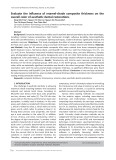
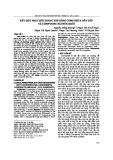
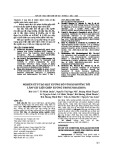
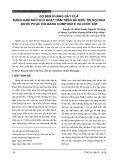



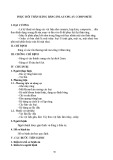
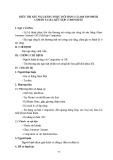
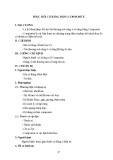


![Bài ôn tập Giải phẫu răng [chuẩn nhất]](https://cdn.tailieu.vn/images/document/thumbnail/2025/20251005/tuyetnhitk1305@gmail.com/135x160/78741759715471.jpg)





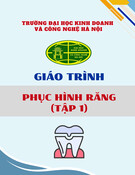
![Bài giảng Glass Ionomer Vương Lam Linh: Tổng hợp kiến thức [Mới nhất]](https://cdn.tailieu.vn/images/document/thumbnail/2025/20250908/dangkhoa5304@gmail.com/135x160/90151757385750.jpg)





